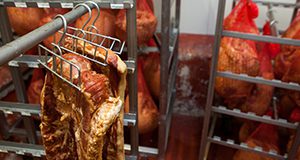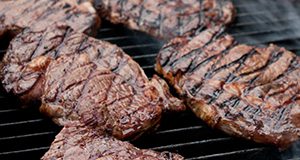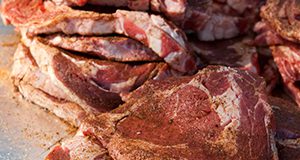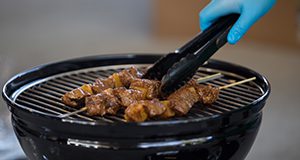The Florida 4-H Poultry BBQ program has existed for years, and the program for red meat cookery has been a huge success in Tennessee 4-H. With sponsorship for the winners at the state level, the Florida 4-H Tailgate Contest program will be a success in Florida as well. This program will strive to promote enjoyable outdoor cooking experiences, encourage the incorporation of animal protein in the diet in order to combat childhood obesity, improve youth nutritional knowledge and cooking skills, and impart knowledge about safe handling and proper degree of doneness to produce safe and delicious meat dishes. This 2-page fact sheet is the fourth publication in the Florida 4-H Tailgate series, and it discusses smoking and slow cooking meat. Written by Chad Carr, Brian Estevez, Sonja Crawford, Jason Scheffler, George Baker, Ed Jennings, and Mark Mauldin, and published by the 4-H Youth Development Department, December 2016.
http://edis.ifas.ufl.edu/4h375
Tag: meat products
Florida 4-H Tailgate: Meat Selection
The Florida 4-H Poultry BBQ program has existed for years, and the program for red meat cookery has been a huge success in Tennessee 4-H. With sponsorship for the winners at the state level, the Florida 4-H Tailgate Contest program will be a success in Florida as well. This program will strive to promote enjoyable outdoor cooking experiences, encourage the incorporation of animal protein in the diet in order to combat childhood obesity, improve youth nutritional knowledge and cooking skills, and impart knowledge about safe handling and proper degree of doneness to produce safe and delicious meat dishes. This 2-page fact sheet is the fifth publication in the Florida 4-H Tailgate series, and it discusses meat selection. Written by Chad Carr, Brian Estevez, Sonja Crawford, Jason Scheffler, George Baker, Ed Jennings, and Mark Mauldin, and published by the 4-H Youth Development Department, December 2016.
http://edis.ifas.ufl.edu/4h376
Florida 4-H Tailgate: Cooking Safety
The Florida 4-H Poultry BBQ program has existed for years, and the program for red meat cookery has been a huge success in Tennessee 4-H. With sponsorship for the winners at the state level, the Florida 4-H Tailgate Contest program will be a success in Florida as well. This program will strive to promote enjoyable outdoor cooking experiences, encourage the incorporation of animal protein in the diet in order to combat childhood obesity, improve youth nutritional knowledge and cooking skills, and impart knowledge about safe handling and proper degree of doneness to produce safe and delicious meat dishes. This 3-page fact sheet is the second publication in the Florida 4-H Tailgate series, and it addresses cooking safety. Written by Chad Carr, Brian Estevez, Sonja Crawford, Jason Scheffler, George Baker, Ed Jennings, and Mark Mauldin, and published by the 4-H Youth Development Department, December 2016.
http://edis.ifas.ufl.edu/4h373
Florida 4-H Tailgate: Cooking Equipment
The Florida 4-H Poultry BBQ program has existed for years, and the program for red meat cookery has been a huge success in Tennessee 4-H. With sponsorship for the winners at the state level, the Florida 4-H Tailgate Contest program will be a success in Florida as well. This program will strive to promote enjoyable outdoor cooking experiences, encourage the incorporation of animal protein in the diet in order to combat childhood obesity, improve youth nutritional knowledge and cooking skills, and impart knowledge about safe handling and proper degree of doneness to produce safe and delicious meat dishes. This 2-page fact sheet is the first publication in the Florida 4-H Tailgate series, and it discusses cooking equipment. Written by Chad Carr, Brian Estevez, Sonja Crawford, Jason Scheffler, George Baker, Ed Jennings, and Mark Mauldin, and published by the 4-H Youth Development Department, July 2016.
http://edis.ifas.ufl.edu/4h372
How Do I Legally Sell Meat from Alligators, Wild Game, or My Farmed Game or Birds in Florida?
 Game meats provide wholesome and nutritious animal protein, but learning the regulations (and which agency has jurisdiction over which regulations) can be burdensome for those who want to be entrepreneurial. This 4-page fact sheet is a “one-stop-shop” for Florida residents who want to sell products from alligators, wild game, or their own farmed game or birds. Written by Chad Carr, Jason Scheffler, Larry Eubanks, Ron Webb, Lee Cornman, Scotland Talley, and Steve Stiegler, and published by the UF Department of Animal Sciences, December 2014. (Photo: iStock/Thinkstock.com)
Game meats provide wholesome and nutritious animal protein, but learning the regulations (and which agency has jurisdiction over which regulations) can be burdensome for those who want to be entrepreneurial. This 4-page fact sheet is a “one-stop-shop” for Florida residents who want to sell products from alligators, wild game, or their own farmed game or birds. Written by Chad Carr, Jason Scheffler, Larry Eubanks, Ron Webb, Lee Cornman, Scotland Talley, and Steve Stiegler, and published by the UF Department of Animal Sciences, December 2014. (Photo: iStock/Thinkstock.com)
http://edis.ifas.ufl.edu/an315
How Do I Legally Sell Meat from My Own Livestock and Poultry in Florida?
 There is much interest in locally produced foods, but the federal, state, and local regulations can be confusing. This 5-page fact sheet is a “one-stop-shop” for Florida residents who want to sell meat from their own livestock and poultry. Written by Chad Carr, Jason Scheffler, Larry Eubanks, Ron Webb, Lee Cornman, Scotland Talley, and Steve Stiegler, and published by the UF Department of Animal Sciences, December 2014. (Photo: iStock/Thinkstock.com)
There is much interest in locally produced foods, but the federal, state, and local regulations can be confusing. This 5-page fact sheet is a “one-stop-shop” for Florida residents who want to sell meat from their own livestock and poultry. Written by Chad Carr, Jason Scheffler, Larry Eubanks, Ron Webb, Lee Cornman, Scotland Talley, and Steve Stiegler, and published by the UF Department of Animal Sciences, December 2014. (Photo: iStock/Thinkstock.com)
http://edis.ifas.ufl.edu/an316
Food Safety for the Holiday Season
 Food is always an important part of holiday festivities, but holiday meals can take a turn for the worse if food safety is not properly practiced when preparing and cooking the food. The food you serve your family and friends can be very harmful if your turkey, ham, or home-prepared meat products are not appropriately handled. The good news is that by practicing four basic food safety measures you can help prevent foodborne illness over the holiday season. This 6-page fact sheet provides information about safe food practices for the holidays. Written by Soohyoun Ahn and Keith R. Schneider, and published by the UF Department of Food Science and Human Nutrition, December 2014. (Photo: Stockbyte/Thinkstock)
Food is always an important part of holiday festivities, but holiday meals can take a turn for the worse if food safety is not properly practiced when preparing and cooking the food. The food you serve your family and friends can be very harmful if your turkey, ham, or home-prepared meat products are not appropriately handled. The good news is that by practicing four basic food safety measures you can help prevent foodborne illness over the holiday season. This 6-page fact sheet provides information about safe food practices for the holidays. Written by Soohyoun Ahn and Keith R. Schneider, and published by the UF Department of Food Science and Human Nutrition, December 2014. (Photo: Stockbyte/Thinkstock)
http://edis.ifas.ufl.edu/fs260
Food Processing: The Meat We Eat (AN283)
 Meat processing technology is used to produce many of the foods we enjoy, such as hot dogs, hamburgers, and chicken nuggets. Recently, the media has focused on certain meat products, giving them names such as “pink slime” and “meat glue.” The names of these products might have many people wondering what we are eating and how the meat we eat is produced. Part of being a good consumer is learning about what you eat, from how the food is made to whether the food is safe. This publication discusses the facts about meat processing so you can make knowledgeable decisions about the meat you eat. This 5-page fact sheet was written by Erica L. Bub, Keith Schneider, Chad Carr, and Matt Hersom, and published by the UF Department of Animal Sciences, December 2012.
Meat processing technology is used to produce many of the foods we enjoy, such as hot dogs, hamburgers, and chicken nuggets. Recently, the media has focused on certain meat products, giving them names such as “pink slime” and “meat glue.” The names of these products might have many people wondering what we are eating and how the meat we eat is produced. Part of being a good consumer is learning about what you eat, from how the food is made to whether the food is safe. This publication discusses the facts about meat processing so you can make knowledgeable decisions about the meat you eat. This 5-page fact sheet was written by Erica L. Bub, Keith Schneider, Chad Carr, and Matt Hersom, and published by the UF Department of Animal Sciences, December 2012.
http://edis.ifas.ufl.edu/an283
Facts and Frequently Asked Questions About Lean, Finely-Textured Beef (AN281)
 Two very similar finely-textured beef products available commercially and produced from slightly different patented processes have received an increased amount of media attention recently, where they have been referred to as “pink slime.” This 4-page fact sheet is intended to answer some of the consumer questions that have arisen as a result of this increased attention. Written by Chad Carr, Dwain Johnson, Joel Brendemuhl, and Larry Eubanks, and published by the UF Department of Animal Science, July 2012.
Two very similar finely-textured beef products available commercially and produced from slightly different patented processes have received an increased amount of media attention recently, where they have been referred to as “pink slime.” This 4-page fact sheet is intended to answer some of the consumer questions that have arisen as a result of this increased attention. Written by Chad Carr, Dwain Johnson, Joel Brendemuhl, and Larry Eubanks, and published by the UF Department of Animal Science, July 2012.
http://edis.ifas.ufl.edu/an281
Compare the Cost per Serving (FCS8718/FY408)
 To find the best buy on certain foods, like meat, it’s important to compare the cost per serving. This 2-page fact sheet includes a table with servings per pound of various beef and chicken cuts, as well as examples of how to determine the price per serving. Written by Jennifer Hillan and Claudia Peñuela, and published by the UF Department of Family Youth and Community Sciences, June 2011. UF/IFAS Photo by Tom Wright.
To find the best buy on certain foods, like meat, it’s important to compare the cost per serving. This 2-page fact sheet includes a table with servings per pound of various beef and chicken cuts, as well as examples of how to determine the price per serving. Written by Jennifer Hillan and Claudia Peñuela, and published by the UF Department of Family Youth and Community Sciences, June 2011. UF/IFAS Photo by Tom Wright.
http://edis.ifas.ufl.edu/fy408
Specialty Meat Marketing Claims: What’s the Difference? (AN191)
American consumers are confused about the differences between meat products with special marketing claims (i.e., organic, natural, naturally raised, and grass-fed) and regular or commodity meat products. This 5-page report discusses these claims as defined by the USDA and addresses the differences between these products for food safety, human health, and eating quality.Written by Chad Carr, Larry Eubanks, and Ryan Dijkhuis and published by the UF Department of Animal Science, April 2011.
http://edis.ifas.ufl.edu/an191
AN252 Ultrasound and Carcass Merit of Youth Market Hogs
AN252, a 5-page illustrated fact sheet by Chad Carr, Dwain Johnson, and Mark Shuffitt, describes the process whereby ultrasound evaluation of the live animal can be used to predict fat thickness and loineye area to determine the carcass merit of youth market hogs. Includes references. Published by the UF Department of Animal Science, October 2010.
http://edis.ifas.ufl.edu/an252
FE822 Attitudes and Preferences of People Aged 55 and Above for Seafood: Summary of Telephone Survey Results
FE822, an 8-page illustrated fact sheet by Lisa House, Allen F. Wysocki, William A. Messina, Jr., and Kathryn Olson, presents a brief summary of information on consumer perceptions of seafood obtained from a 2008 survey to identify the attitudes and consumption behavior of consumers aged 55 and
older for fish, shellfish, and aquaculture products. Published by the UF Department of Food and Resource Economics, April 2010.
http://edis.ifas.ufl.edu/fe822
AN222 Growth of Generic E. coli and Aerobic Bacteria on Beef Muscle held at 50°F for 8 Hours
AN222, a 4-page fact sheet by Larry Eubanks, Chad Carr, and Chris Pantaleo, presents the results of a study to determine the growth of generic E. coli and aerobic bacteria as indicators of pathogenic bacteria on beef muscle held at 50°F for eight hours. Includes references. Published by the UF Department of Animal Sciences, November 2009.
http://edis.ifas.ufl.edu/AN222
AN229 Fresh Meat Selection for Consumers
AN229, a 5-page illustrated fact sheet by Chad Carr, Ed Jennings, and Larry Eubanks, aims to provide consumers with a solid working knowledge of fresh meat terminology so that they can select meat cuts that will perform desirably in all recipes. Includes references. Published by the UF Department of Animal Science, October 2009.
http://edis.ifas.ufl.edu/AN229
AN220 Datil Pepper Summer Sausage: An Innovative Product Using Florida Datil Peppers
AN220, a 4-page fact sheet by Sally K. Williams, Noufoh Djeri, Edsel Redden, David Dinkins, and David Bearl, describes a new summer sausage product featuring the datil pepper, which has been grown in the St. Augustine area for around 230 years — the formulation and the the results of taste tests. Includes references. Published by the UF Department of Animal Sciences, July 2009.
http://edis.ifas.ufl.edu/AN220
AN206 The Effects of Chilling Temperature of Bone-in Fully-Cooked Hams on Microbial Growth and Shelf Life
AN206, a 4-page fact sheet by C. Chad Carr and Larry Eubanks, reports the results of a study to determine the effect of not meeting the USDA’s suggested standard for chilling on the microbial growth and retail acceptability of bone-in, fully-cooked hams. Includes references. Published by the UF Department of Animal Science, October 2008.
http://edis.ifas.ufl.edu/AN206
AN-204/AN204 Custom and Retail Exempt Meat Processing
AN204, a 4-page fact sheet by Chad Carr, Larry Eubanks, and Ryan Dijkhuis, explains the exemptions for custom and retail exempt meat processors, and also covers Florida Sunshine Law
specific to meat processors. Published by the UF Department of Animal Science, September 2008.
http://edis.ifas.ufl.edu/AN204
AN203/AN203 USDA Inspected Livestock Slaughter Facilities in Florida
AN203, a 3-page ilustrated fact sheet by Chad Carr, Larry Eubanks, and Ryan Dijkhuis, provides a comprehensive list of USDA inspected meat animal slaughter facilities in Florida. Published by the UF Department of Animal Science, July 2008.
http://edis.ifas.ufl.edu/AN203
AN202/AN202 The Effects of Freezing on the Processing Characteristics and Palatability Attributes of Fresh Pork Legs
AN202, a 5-page report by B. G. Sapp, D. D. Johnson, L. E. Eubanks, and J. H. Brendemuhl, presents the results of a study to ascertain if de-boning and vacuum packaging of fresh hams for frozen storage had any effect on the processing qualities and oxidative rancidity of the cured ham as compared to the traditional method of freezing and storing of fresh bone-in hams. Includes references. Published by the UF Department of Animal Science, May 2008.
http://edis.ifas.ufl.edu/AN202



